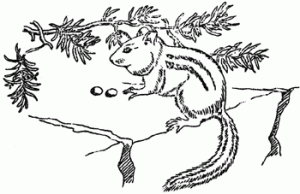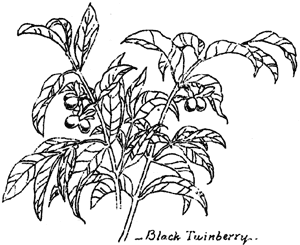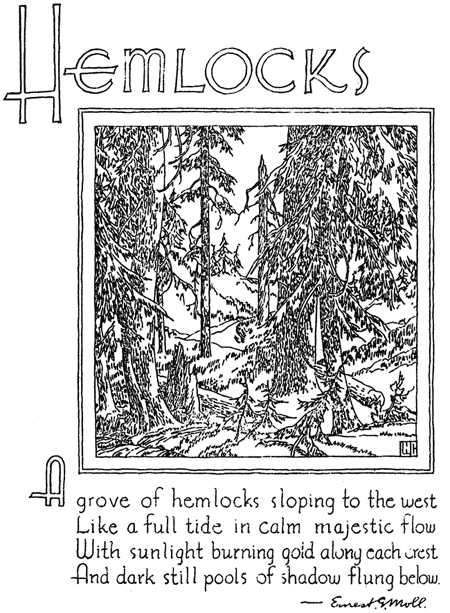The Squirrel and his Relatives
By Ray Coopey, Ranger-Naturalist
The rodents, or gnawing animals, constitute a group which, in populated or agricultural areas, are considered as pests to mankind. In a mountainous district, such as Crater Lake, quite the reverse holds true and the absence of this most interesting and varied assemblage of animals would be almost immediately noticed by even the most unobserving of the park visitors.
For instance, the animal entertainment furnished by the golden mantled ground squirrels (Callospermophilus c. chrysodeirus) who carry away such large quantities of peanuts in their pouched checks while visitors are at the same time appreciating the beauties of Crater Lake would be sorely missed by young and old alike. Especially the older people left behind by the youthful members in search of exercise, find here an amusing pastime and no small degree of solace. Although a very small proportion of the peanuts gathered from the willing hands are eaten immediately, it may interest the donors to know that at least a portion of this remaining lion’s share is carried to the burrows and placed in storage for a “snowy day”. The hibernating period during which these animals are totally inactive and in a torpid state, probably does not exceed four months; during the coldest part of winter, however, a period of two to three months in late fall and early spring, occurs when they are intermittently active and when little outside food is available. It is during this time that the reserve storage is tapped and no doubt many kindly thoughts are given to the generous tourists of the preceding summer.
Much less bold in their habits but none-the-less interesting are the Klamath Chipmunks (Eutamias amoenus amoenus) which are also found along the rim parapet but are outnumbered about ten to one by the squirrels. The untrained eye can readily distinguish them from the squirrels by their smaller size, more pointed head, and the presence of strips on the side of the head, together with their reticent nature. They, too, live in burrows dug under the shelter of a rock or beneath a tree or stump. Toward the end of the summer season both animals may be seen busily engaged in stuffing their mouths with dried grasses, paper, moss, and other debris to be carried to their burrows where a soft bed is made for the winter.
In the lower regions of the Park, one’s attention is constantly attracted while wandering through the pine forests by the loud scolding of the large Cascade Pine Squirrel (Sciurus douglassi cascadensis) This grayish brown animal with the distinguishing yellowish-red underparts live the greater part of its life among the branches of the coniferous trees, descending to the ground only to scamper to another tree or to pick the seeds from cones which have previously been severed from their aerial attachment. These squirrels, in contrast to their previously mentioned relatives, construct their nests in the hollow cavities of trees, lining them with moss and lichens and storing quantities of seed for consumption before and after the true period of hibernation which occurs during the dead of winter.
Associated with the Pine Squirrel in its tree-dwelling nature is the Flying Squirrel. The two types in the park, the Klamath Flying Squirrel (Glaucomys sabrinus klamanthensis)and the Cascade Flying Squirrel (Glaucomys sabrinus fuligninosus), true to the habits of their clan, are strictly night roamers, gathering their food and performing their gliding flights under the cover of darkness. Sun-up finds them back in their nests among the branches or in the hollow trunk of a tree, ready to sleep through the day. Like the other squirrels, they are inactive during a part of the winter.
One of the most sluggish and yet the most hardy of the larger rodents is the porcupine(Erethizon epixanthum epixanthum). Living on the tender inner bark of the conifers, it spends most of its time in the tops of trees, remaining active throughout the winter season. Few of the meat eating predators are clever enough to penetrate the fortress of quills surrounding its body, so it moves with slow deliberate actions as it pursues its hum-drum existence. The porcupine is usually seen abroad at night, and when surprised in the midst of its wandering, may be driven with a stick much as a hog might be driven to market.
One walking through the green grass-matted meadows near the streams flowing to the south and west in the park will find burrows and an abundance of other evidences of a thriving population of the small woodland mice, pocket gophers and moles. In these densely settled areas are found a variety of mice including the white footed, wood or deer mouse (Peromyscus maniculatus gambeli); vole or meadow mouse (genusMicrotus); and the kangaroo or jumping mouse (genus Zapus) — the latter being unique in the possession of a jumping habit after the fashion of the well known kangaroo and having a long tail extending out behind to act as a counter-balance for the front part of the body. They have well developed hind legs as does the kangaroo, while the fore legs are shorter and comparatively weaker. All these mice mentioned live largely on green vegetation and grass seeds.
The second group of animals found in these locations is made up of Moles and Gophers. These two are true miners of the rodents, coming to the surface only on rare occasions. The Mazama Pocket Gopher (Thomomys monticola mazama) is, like the Ground Squirrel, equipped with check pockets which he fills hurriedly with the roots of plants and then retires to the depth of his burrow to munch them at his leisure. The Crater Lake Mole (Scapanus latimanus alpinus) eats small ground insects and worms, harbors an enormous appetite, and devours his victims “on location”.
Living in the rocky slopes and cliffs, particularly in the higher elevations of the park, are found associated together, three animals of widely different habits. The Cony or Pika (Ochotona princeps brunnescens), commonly called the rock rabbit, though not a true rodent, lives deep in the crevices of the crater wall and on the surrounding peaks. They are harvesters by nature, gathering and seasoning green vegetation during the summer to be stored in their homes and consumed during the winter, remaining active throughout the season, even though the snow may be piled many feet deep overhead.
The second animal, the Marmot (Marmoto flaviventris flaviventris), commonly called the rock chuck or wood chuck, belongs to the yellow footed marmot group which includes the hoary marmot of the north, noted for his whistling habit. The whistling proclivities seem not as well developed in the chuck found in this southern portion of the Cascades. A related species of this animal, the ground hog of the east and south, according to common belief, has supposedly, some phenomenal power of control over the spring weather. The origin of this belief, perhaps, may be attributed to the habit the animal has of emerging from its winter sleep early in February, and if the weather is agreeable, remaining out; in case inclement weather is in vogue, however, it immediately returns for an additional period of sleep. It is easily seen, from the above, that the disappearance of the animal is an effect and not a cause of the weather.
The third rodent found in this habitat and the one completing this discussion, is the Wood Rat (Neotoma cinera occidentalis), also answering to the name of pack rat and trade rat. Their bid for attention comes from their habit of building large, loosely constructed nests of sticks in crevices of rocks or, in fact, in any protected place, and their kleptomaniac inclinations which lead them to pilfer all types of shiny or bright colored objects — often proving very annoying if nesting near an inhabited residence; thimbles, silver ware, bright pieces of cloth and even shoes disappearing miraculously.
Some Fruits of Crater Lake Plants
By Elmer I. Applegate, Ranger-Naturalist
No less interesting than the flowers are the fruits of some of the plants of Crater Lake National Park. These include not only fleshy fruits, but seed-pods, capsules, grains and the like. Fruit in a botanical sense is any seed vessel with its contents, including any accessories that may be joined to it. In the present account, however, only the fleshy fruits are considered, which, as far as our area is concerned, means only berries or berry-like fruits.
Twenty-one genera with thirty-five species are included in the list. Of the number that are edible, some are so small and produced in such limited quantities that they are of no practical food value. Of those of any such use, might be mentioned two huckleberries, one each of honeysuckle, blackberry, raspberry, strawberry, thimbleberry, serviceberry, gooseberry and Oregon grape — nine berries in all, included in only five genera. None of these are found in abundance, so that the fruit value of the park is almost negligible as far as human consumption is concerned. In addition to these, some are highly ornamental in fruit, adding much to the floral beauty of the park.
Four huckleberries (Vaccinium) occur. The Big Huckleberry (V. membranaceum) is a rather tall shrub with large amber or brownish berries, turning black late in the season, found in the upper forests and thriving best on northerly slopes, especially near streams. It is the most productive of all the species of the genus in the southern Cascades, and much used by both white people and Indians; known by the Klamaths asewaum, and the name Ewaumcan was given by them to the big huckleberry patch southwest of the park. More abundant in dryer situations and in middle elevations, is the broom or Leiberg huckleberry (V. scoparium), especially in the lodgepole pine forests. The bushes are low with angular stems and small leaves, and very small red fruit of pleasant acid flavor. It is widely distributed from the coast mountains to the Rockies. The species was named by Leiberg from specimens collected by him at Crater Lake in 1896. Dwarf Huckleberry (V. caespitosum) resembles most the larger species, but is low and usually matted, with smaller dark blue, more glaucus berries, and usually found in the upper forests and often on the highest ledges. In wet meadows and bogs, especially along the water courses of the west slope, are found dense colonies of Swamp Huckleberry (V. occidentale). The bushes are two feet high or less with leaves of a grayish cast and longish blue-black berries covered with a dense bloom. The fruit is of medium size and fine flavor, but not prolific.
Three erect bush-form species of honeysuckle (Lonicera) are to be found. Of these Black Twin-berry (L. involucrata) is rather widely distributed , but most frequently along streams and borders of wet meadows. The pairs of yellow flowers and elongated black berries are subtended by large reddish bracts which give the plant a striking appearance. With about the same habitats and distribution, Red Twinberry (L. conjugialis) has smaller and nearly black flowers and bright red berries which are almost completely united into a double fruit. Swamp Honeysuckle (L. utahensis) grows only in wet or boggy places. The flowers are pure white, turning yellowish later, growing in pairs among the grayish-green leaves. The pleasantly acid red fruit was sometimes used by the early settlers in Wood River Valley, and called by them “cranberry”. The species is rare in the park, occurring sparingly at Boundary Springs perhaps other similar places.
Six species of gooseberry and currant contribute to the small-fruit list. The most noteworthy of these is the Crater Lake Currant (Ribes orythrocarpum), the most abundant shrub of the upper forests, its creeping stems forming a fine carpet for the forest floor. The flowers are saucer-shaped and of a copper-color. The clusters of bright red berries are very attractive. The species was named by Dr. F. V. Colville in 1896. Although so abundant in the park, it is not found far without its boundaries. None of the species here are edible except R. inerme, the fine gooseberry found along streams in the yellow pine belt. It most resembles the common cultivated form, the wine-colored fruit very similar in size and flavor, often used in pioneer days for sauce and pies. Sticky Currant (R. viscossimum) has large blue gummy berries with a bloom; and the Waxy Currant (R. cereum) bright red berries. Both forms have long tubular flowers. The Spiney Currant (R. lacustre) is common along the water courses and covers moist banks. The black berries are relatively small. Trailing in the hemlock forests, is occasionally seen the Siskiyou Gooseberry (R. binominatum), the berries covered with stout yellow spines.
Bitter Cherry (Prunus emarginata) is plentiful in the yellow pine woods, and extends into the upper levels where it is often seen on rocky ledges. The small bright red drupaceous fruit is intensely bitter.
Serviceberry (Amelanchier). The species is not well defined. This is sometimes identified as florida. The tall, much branched shrub is covered with snowy white flowers. The berries are dark purple, almost black. It is most common in the yellow pine woods, although rather plentiful on ledgy northerly slopes higher up. Lacking acidity, the fruit is somewhat insipid.
Oregon Grape (Mahonia nervosa) is found in the forest areas well down toward the western boundary, especially about the headwaters of Redblanket Creek. The simple stem bears a tuft of long pinnate leaves with numerous holly-like leaflets. The blue-glaucus berries grow in an erect elongated cluster, and are very acid.
Mostly along streams and margins of wet meadows, in lower and middle elevations, occurs the Virginia Strawberry (Fragaria virginiana). The fruit is delicious but not plentiful in many places in the park.
Cascara (Rhamnus purshiana) is a tall shrub with rather large elliptical leaves and very small greenish flowers. The berries are black with one or two large flattish seeds, and a very bitter taste. The bark is used medicinally. Only occasionally seen on ledgy slopes. Sometimes found on the inner talus slopes as at the Devil’s Backbone.
Two Gaultherias, ovatifolia, and humifusa, small creeping evergreen shrubs belonging to the heath family, occur along streams and about wet meadows toward the western boundary. The small red berries have a very pleasant acid taste. Another pair of shrubs belonging to the same family, are the manzanitas. They are evergreen also, and have crooked branches with smooth and polished bark. The flowers are pinkish with urn-shaped corollas, the fruit berry-like, stony, and pulp becoming mealy and dry. Abundant in the lower forest areas, is the higher upright green-leaved species (Arctostaphylos patula), which is replaced in the upper reaches by the low mat-forming (A. nevadensis).
An herbaceous plant of moist shady places it the Baneberry, (Actaea spicata arguta). Its large leaves are deeply cut into many leaflets. The showy red berries are borne on an erect elongated raceme.
Dwarf Juniper (Juniperus sibirica). This low, usually prostrate shrub, closely related to the cone-bearing trees, is rare in the park, occurring only on the highest points. The fruit is a small modified cone, berry-like, globose, blue and covered with white bloom.
Frequently seen in the moist places under coniferous trees, is Bride’s Bonnet (Clintonia uniflora). The single white liliaceous flower is borne on a stype-like stem arising from two or three basil leaves. The berry is blue.
The two species of Solomon’s Seal (Smilacona), stellata with nearly black berries, andamplexicaulis which has light red fruit covered with dark red specks, are common in many places in the park.
Resembling the last in foliage, Twisted Stalk (Streptopus curvipes) grows in moist forest stream banks. The red ovoid berries are borne on the underside of the pinnate leaves.
Rare in the region, and known only along streams of the western border, is the dwarf dogwood or Bunchberry (Cornus canadensis). Less than a foot high, it has flowers with large white bracts like the large Nuttall Dogwood. The bright red berries form a dense globular bunch.
The red-fruited elder (Sambucus racemosa callicarpa), fine in flower, in fruit is perhaps the most attractive shrub in the park. The large dense and finely rounded clumps with deep green foliage and elongated bunches of red berries, is common over considerable areas of the upper reaches. Nowhere does it show to better advantage than on Wizard Island. As seen from a boat along the shore, it attracts much attention, standing out most conspicuously against the black lava background. This Crater Lake elder was named by Leiberg, S. leiosperma, the species being based upon seed characters which do not seem of sufficient value to entitle it to the name.
Another very showy-fruited shrub, often associated with the last is the Sitka Mountain Ash (Sorbus sitchensis). Morphologically, the fruit is essentially the same as a very diminutive apple, being not more than a quarter of an inch in diameter. The red berries are borne in large dense umbel-like clusters quite different from the apple, and the leaves are pinnately compound with numerous serrate leaflets, still further differentiating the plant from its close relative. The many tall stems form large clumps, and are a familiar sight in much of the forested areas. The autumn foliage is also very attractive, especially noticeable along streams on the inner talus slopes.
Hemlocks
By Ernest G. Moll, Ranger-Naturalist
A grove of hemlocks sloping to the west
Like a full tide in calm majestic flow
With sunlight burning gold along each crest
And dark still pools of shadow flung below.
Other pages in this section





